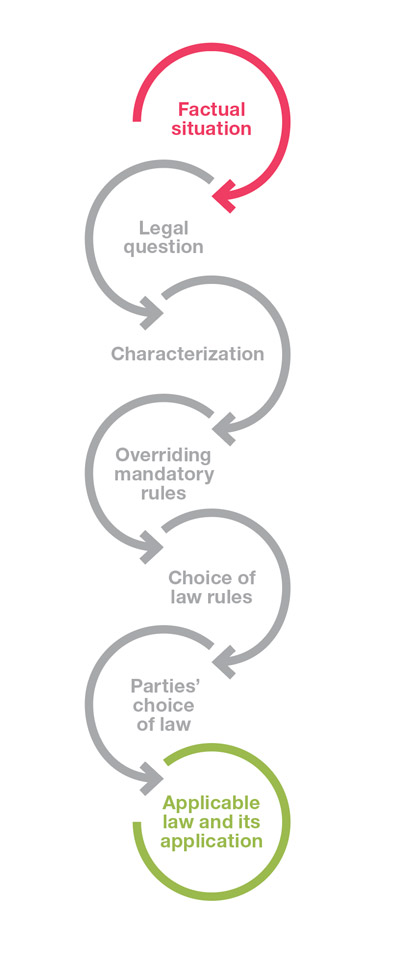By Annabelle Bennett, Former Judge, Federal Court of Australia, Sydney, Australia, and Sam Granata, Judge, Court of Appeal, Antwerp, Belgium, and Benelux Court of Justice, Luxembourg
In the modern economy, market transactions have become more complex, value chains have become more global and the movement of intangible capital, such as intellectual property (IP)-protected technology, designs, brands and creative works, has become more mobile.

In this context, court cases relating to the infringement of IP rights covering goods and services that are global in their use can have an impact worldwide. While IP rights apply within territorial boundaries, the interconnected nature of the modern economy means that judges tasked with disputes relating to IP rights are ever more frequently finding themselves at the crossroads of IP law and private international law, which concerns relations between private parties across national borders.
Take, for example, the following scenario:
Company A and Company B, with headquarters in Belgium and Australia respectively, enter into a license agreement regarding the distribution of the goods produced using a technology patented by Company A in Belgium and Australia. The license is governed by the law of Belgium. A dispute over an alleged breach of the license arises and Company A initiates a court proceeding in Belgium, where it has its headquarters. Instead of, or as well as, bringing claims under the license agreement, Company A claims patent infringement by Company B in Belgium and Australia. Company B counterclaims that Company A’s patents in both countries are invalid.
Confronted with this case, judges may first hope that parties settle before either of them has to decide, but if there is no willingness to settle, the judges will face questions of private international law.
The increasing relevance of private international law
Private international law becomes more relevant when facing the challenges unearthed by the heightened mobility of IP and the globalized nature of commercial dealings. This intersection between IP and private international law has attracted considerable academic and judicial attention, as it raises important questions about which court has jurisdiction to adjudicate cross-border disputes on IP, which law is to be applied, and whether foreign IP-related judgments can be recognized and enforced.
Recognizing the need to support the work of judges and lawyers around the world in navigating these issues, WIPO and the Hague Conference on Private International Law (HCCH) joined ranks to develop a practical guide on IP and private international law by judges, for judges.
A guide for judges by judges
When Private International Law Meets Intellectual Property Law: A Guide for Judges, provides experts who specialize in one of the two fields of law with a reliable overview of how these fields intertwine. In writing the guide, we do not claim to offer an exhaustive treatment of the law in all areas, but seek to clarify the operation of private international law in IP matters with illustrative references to selected international and regional instruments and national laws.
The purpose of the Guide is to help ensure that judges are better placed to apply the laws of their own jurisdiction, supported by an awareness of key issues concerning jurisdiction of the courts, applicable law, the recognition and enforcement of judgments, and judicial cooperation in cross-border IP disputes.
The intersection between IP and private international law […] raises important questions about which court has jurisdiction to adjudicate cross-border disputes on IP, which law is to be applied, and whether foreign IP-related judgments can be recognized and enforced.
It does not advocate any particular approach to substantive issues of law or provide any solutions in individual cases. By highlighting the main issues in this complex area, we aim to assist judges and lawyers in many different countries to make informed decisions. Designed to be as user-friendly as possible, the Guide uses straightforward language, aided by diagrams and practical examples, to help explain key concepts that may find application. As it is directed to a worldwide audience, we have made every effort to approach the analyses of the cross-border issues presented from a civil law and a common law point of view.
Exploring the intersection between private international law and IP law
The Guide leads the reader through the issues that characterize the intersection between private international law and IP. The opening chapters include a general overview of the separate and distinct fields of IP and private international law and touch on the intersection between them. They also explore the various legal frameworks that regulate this intersection. For example, we examine the rules of private international law that govern IP relationships focusing on the international and regional instruments as well as how these rules are integrated into IP treaties and registration systems. In this part of the Guide we direct the reader to some non-binding instruments dealing with IP and private international law (soft law initiatives).
The Guide also provides a step-by-step roadmap for legal practitioners dealing with cross-border IP issues:

For example, a court will first be required to deal with competence issues. The court where proceedings are commenced must first decide whether it is an appropriate place for the determination of the proceedings. That requires consideration of what connection the parties, the subject matter and the relief sought have with that State. Whether a court is competent to decide an IP dispute – in other words, whether it has jurisdiction over the dispute – will be decided according to the private international law rules of the State where the court is located. These rules may also be affected by international or regional private international law or IP instruments. It is possible that courts in more than one State have jurisdiction to decide a dispute. In practice, this allows the claimant to select a court, which is sometimes referred to as “forum shopping.”

Having determined its jurisdiction, the court will need to determine the law applicable to the cross-border IP case. In the Guide we identify the points of consideration for a court when making this determination. While we attempt to offer a neutral approach to the issue, we explain that courts should be aware that national rules may interact with this process and note that that some steps in this process may overlap with points considered in determining jurisdiction. Figure 2 provides a graphical overview of the multiple-step approach outlined in the Guide.
We then attempt to answer questions that may arise as to whether and how the court’s judgment can be recognized and enforced in another State. Such questions will frequently arise where the defendant against whom a judgment has been ordered is located in another State or has assets located in another State. In this, we make a distinction between the courts that are involved in the recognition and enforcement stages: (i) the court that made the judgment (the court of origin) and (ii) the court of the State that is requested to recognize or enforce the judgment of the court of origin (the court addressed).
Finally, the Guide deals with issues relating to administrative or judicial cooperation. In cross-border civil or commercial transactions or disputes, difficulties can be encountered if the defendant or a witness is domiciled, or the evidence is located, outside the State where the proceedings are initiated; if a foreign State issues the necessary public documents; or if parallel proceedings arising out of the same dispute are initiated in different States. This is because each State has its own legal and administrative systems.
Closer cooperation between the authorities of different States can eliminate obstacles deriving from the complexity of different national systems. In the Guide we direct the reader to Conventions developed by the Hague Conference on Private International Law with the aim of facilitating cooperation through different mechanisms.
